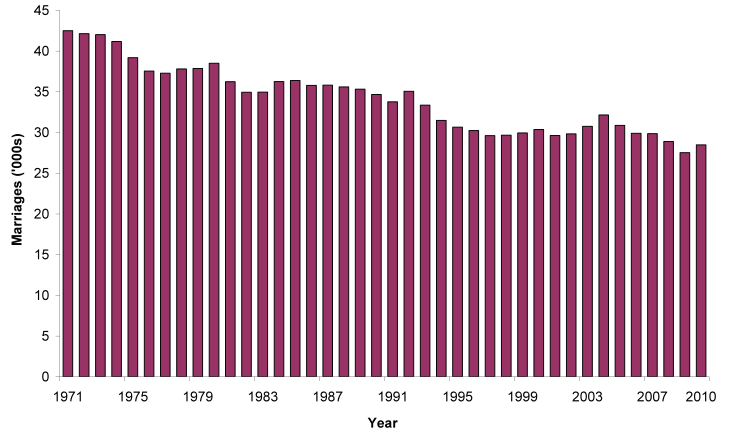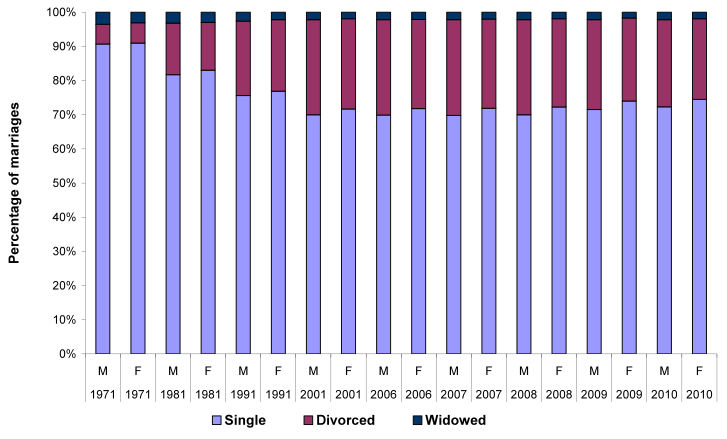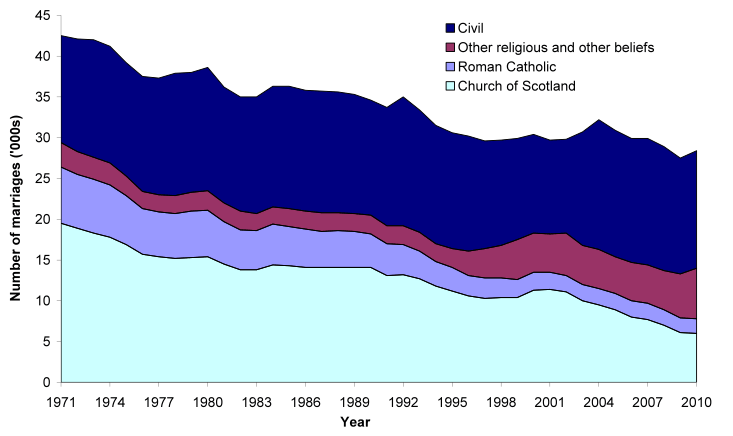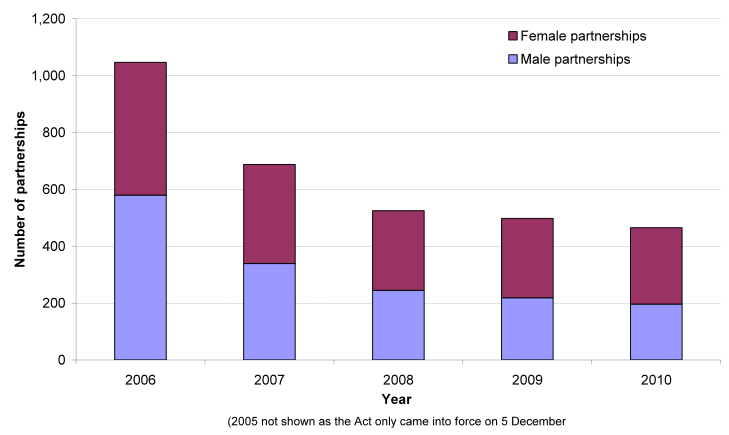Chapter 6 – Marriages and Civil Partnerships
Marriages
There were 28,480 marriages in Scotland in 2010, 956 (3.5 per cent) more than in 2009. Figure 6.1 shows that, following a decline from over 40,000 marriages a year in the early 1970s, the annual total levelled out at around 30,000 in the mid-1990s, but fell each year from 2005 to 2009. The highest total recorded since 1993 was 32,154 in 2004 whilst the 2009 total was the lowest since Victorian times.
The information in this section covers all marriages registered in Scotland, regardless of where the bride and groom lived. In 2010, there were 6,799 ‘tourism’ marriages (24 per cent of all marriages) where neither the bride nor groom was resident in Scotland. This represents little change from 6,664 (24 per cent) in 2009. Gretna continues to be a popular venue for marriages, and the 3,680 registered in 2010 (13% of all marriages) were 4 per cent up on 2009 but over a third down on the record total of 5,555 in 2004 (17% of all marriages in Scotland in 2004). In 2010, 83 per cent (3,067) of the marriages at Gretna did not involve a Scots resident.
Of course, many couples who live in Scotland go abroad to be married. These marriages are not included, and only some come to the attention of the Registrar General through notification to British consular authorities.
Figure 6.1 Marriages, Scotland, 1971-2010

Marital status at marriage
Figure 6.2 shows the percentage of marriages by marital status at the time of marriage between 1971 and 2010. The percentage of people marrying who had been divorced rose from just under 6 per cent in 1971, to over a quarter in 2001 (28 per cent for grooms and 26 per cent for brides). The majority of this shift reflects a reduction in the proportion of marriages where one of the partners had never been married. The percentage was around 25 per cent in 2010 (25 per cent for grooms and 24 per cent for brides). The proportion of those marrying who were widowed (2 per cent in 2010) has hardly changed since 2001.
Figure 6.2 Marriages, by marital status and sex of persons marrying, 1971-2010

Age at marriage
The average age at marriage has risen for both males and females. For first marriages, the average age of grooms who were bachelors has risen from 30.5 in 2000 to 32.5 in 2010; the comparable figures for brides who were spinsters are 28.6 in 2000 and 30.7 in 2010.
Marriages by type of ceremony
Civil marriages are conducted by registrars, and they have wide discretion over the form of the ceremony, to meet couples' wishes, as long as there are no religious references. There were 14,449 civil marriages in 2010, when they accounted for just over half (51 per cent) of all marriages compared to just under one-third (31 per cent) in 1971 (Figure 6.3).
The trend in civil marriages mainly reflects a decline in the number of religious ceremonies during the past thirty to forty years. The small increase in religious marriages during the period 1997-2002 was largely associated with the increase of ‘tourism’ marriages, of which a significant proportion were carried out at Gretna. Since then, there has been a decrease in the number of religious and other belief marriages, from 16,890 in 2003 to 13,285 in 2009 followed by an increase to 14,030 in 2010.
Religious marriages are conducted by a wide range of celebrants. The largest number of religious marriages were carried out by ministers of the Church of Scotland, who conducted 6,005 marriages in 2010. The other religious bodies conducting more than 500 marriages in 2010 were the Roman Catholic Church (1,776), Assemblies of God (879), Scottish Episcopal Church and other churches of the Anglican Communion (695), and the Methodist Church in Scotland (522). Humanist celebrants have been authorised to conduct marriages in Scotland since 2005. In 2010 they officiated at 2,092 marriages, compared with 1,544 in 2009, 1,026 in 2008, 710 in 2007 and 434 in 2006.
Figure 6.3 Marriages, by type of ceremony, 1971-2010

Until 2002, civil marriages could only be held in registration offices. The Marriage (Scotland) Act 2002 allowed registrars to conduct ceremonies in other approved places, from June 2002. In May 2011, there were almost 900 approved venues in Scotland, including castles, hotels, clubs and a small number of outdoor venues in gardens or the countryside. During 2010, 7,409 civil ceremonies (26 per cent of all marriages and 51 per cent of civil marriages) were conducted at these ‘approved places’. Although similar to the number of ceremonies in 2009, this represented an increase of 114 per cent on 2003, the first full year of the new arrangements.
In 2010, 51 per cent of the religious marriages were celebrated in places of worship while just under half (49 per cent) of civil marriages took place in registration offices.
Civil Partnerships
The Civil Partnership Act 2004, which applies throughout the UK and came into force on 5 December 2005, allows same-sex couples to register their partnership.
During 2006, the first full year of operation, 1,047 partnerships were registered in Scotland. In 2007, 688 partnerships were registered. This decrease was expected, because many long-standing relationships would have been registered as civil partnerships in the first full year of registration. In 2008 and 2009, there were further decreases to 525 and 498 registered partnerships respectively and in 2010 there were 465 registrations – 197 male couples and 268 female couples (Figure 6.4).
Figure 6.4 Civil partnerships, 2006-2010

More information about marriage and civil partnership statistics
More detailed information about Scotland’s marriages and civil partnerships can be found at: http://www.nrscotland.gov.uk/statistics-and-data/statistics/statistics-by-theme/vital-events/marriages-and-civil-partnerships
Or in the marriages and civil partnership section of the Vital Events Reference Tables 2010 at: http://www.nrscotland.gov.uk/statistics-and-data/statistics/statistics-by-theme/vital-events/general-publications/vital-events-reference-tables/archive/2010/section-7-marriages-and-civil-partnerships